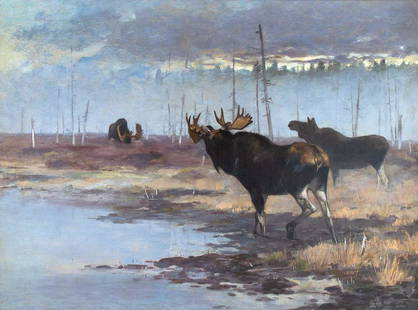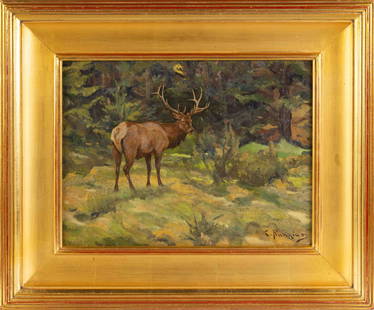
Carl Clemens Moritz Rungius (1869-1959)
Similar Sale History
View More Items in PaintingsRelated Paintings
More Items in Paintings
View MoreRecommended Art
View More




Item Details
Description
Carl Clemens Moritz Rungius (1869-1959)
Wapiti, 1907
Signed "C. Rungius" lower right
Oil on canvas, 32 by 24 inches
Inscribed "Copyright 1907" lower left Exhibited at The Academy of the Arts, Easton, Maryland, In Search of Big Game: Animals in Art, November 7 -December 3, 1997 “For sportsman such as Theodore Roosevelt, the conquest of the American wilderness, which began with Daniel Boone, was seen as a masculine ideal of the hard, outdoor life symbolized best by the collecting of trophy heads. Among the most desirable trophies was the wapiti, whose antlers were greatly admired as masterpieces of symmetrical grandeur…Among hunters, however, the stag remained a lordly icon that couldn’t be abandoned, and for Rungius, an artist working in the European tradition of sport and art, the iconography of the stag was crucial...” - The Glenbow Museum, "Carl Rungius: Artist and Sportsman" This majestic and important oil titled Wapiti was selected as the frontispiece in C. Gordon Hewitt’s "The Conservation of the Wild Life of Canada," published by Scribner & Sons in 1921. This landmark publication marked the start of an increasing awareness of the value of big game animals, which were rapidly disappearing from the continent, and called for safeguards to protect North America’s indigenous species from extinction. The work is also illustrated in the Glenbow Museum’s definitive publication "Carl Rungius: Artist & Sportsman." Rungius wrote, “The noblest game of all- elk- bore a resemblance to the red deer of Europe. There a stag was considered the noblest game of all and I felt that I should follow that tradition.” Rungius’ Wapiti relates to Sir Edwin Landseer’s (1802-1873) celebrated painting, "The Monarch of the Glen," which was widely distributed through prints made from steel engravings. Landseer's frontal depiction of a red stag on a hillside is one of the most iconic and recognizable wildlife images worldwide. Both works are striking compositions, featuring a magnificent bull rising up on the crest of a ridge, with a dramatic, mountainous landscape as the backdrop. Rungius’s nod to Landseer is apparent in Wapiti, but he has revitalized and expanded the subject, giving the elk a fresh North American look. In Wapiti, Rungius captures the spirit of the North American wilderness as something to be appreciated for its beauty, yet respected for its might. Painted around the same time as the Glenbow Museum’s masterpiece, "On Yukon Waters," Wapiti has comparably expert brushwork and warm colors. It ranks as one of Rungius’s masterworks.
Provenance: Private Collection, Virginia, by descent in the family
Literature: The Glenbow Museum, "Carl Rungius: Artist and Sportsman," Toronto, Canada, 2001, p. 22, illustrated. C. Gordon Hewitt, "The Conservation of the Wild Life of Canada," New York, 1921, frontispiece,
Wapiti, 1907
Signed "C. Rungius" lower right
Oil on canvas, 32 by 24 inches
Inscribed "Copyright 1907" lower left Exhibited at The Academy of the Arts, Easton, Maryland, In Search of Big Game: Animals in Art, November 7 -December 3, 1997 “For sportsman such as Theodore Roosevelt, the conquest of the American wilderness, which began with Daniel Boone, was seen as a masculine ideal of the hard, outdoor life symbolized best by the collecting of trophy heads. Among the most desirable trophies was the wapiti, whose antlers were greatly admired as masterpieces of symmetrical grandeur…Among hunters, however, the stag remained a lordly icon that couldn’t be abandoned, and for Rungius, an artist working in the European tradition of sport and art, the iconography of the stag was crucial...” - The Glenbow Museum, "Carl Rungius: Artist and Sportsman" This majestic and important oil titled Wapiti was selected as the frontispiece in C. Gordon Hewitt’s "The Conservation of the Wild Life of Canada," published by Scribner & Sons in 1921. This landmark publication marked the start of an increasing awareness of the value of big game animals, which were rapidly disappearing from the continent, and called for safeguards to protect North America’s indigenous species from extinction. The work is also illustrated in the Glenbow Museum’s definitive publication "Carl Rungius: Artist & Sportsman." Rungius wrote, “The noblest game of all- elk- bore a resemblance to the red deer of Europe. There a stag was considered the noblest game of all and I felt that I should follow that tradition.” Rungius’ Wapiti relates to Sir Edwin Landseer’s (1802-1873) celebrated painting, "The Monarch of the Glen," which was widely distributed through prints made from steel engravings. Landseer's frontal depiction of a red stag on a hillside is one of the most iconic and recognizable wildlife images worldwide. Both works are striking compositions, featuring a magnificent bull rising up on the crest of a ridge, with a dramatic, mountainous landscape as the backdrop. Rungius’s nod to Landseer is apparent in Wapiti, but he has revitalized and expanded the subject, giving the elk a fresh North American look. In Wapiti, Rungius captures the spirit of the North American wilderness as something to be appreciated for its beauty, yet respected for its might. Painted around the same time as the Glenbow Museum’s masterpiece, "On Yukon Waters," Wapiti has comparably expert brushwork and warm colors. It ranks as one of Rungius’s masterworks.
Provenance: Private Collection, Virginia, by descent in the family
Literature: The Glenbow Museum, "Carl Rungius: Artist and Sportsman," Toronto, Canada, 2001, p. 22, illustrated. C. Gordon Hewitt, "The Conservation of the Wild Life of Canada," New York, 1921, frontispiece,
Buyer's Premium
- 18%
Carl Clemens Moritz Rungius (1869-1959)
Estimate $150,000 - $250,000
3 bidders are watching this item.
Shipping & Pickup Options
Item located in Plymouth, MA, usSee Policy for Shipping
Payment

Related Searches
TOP









































































